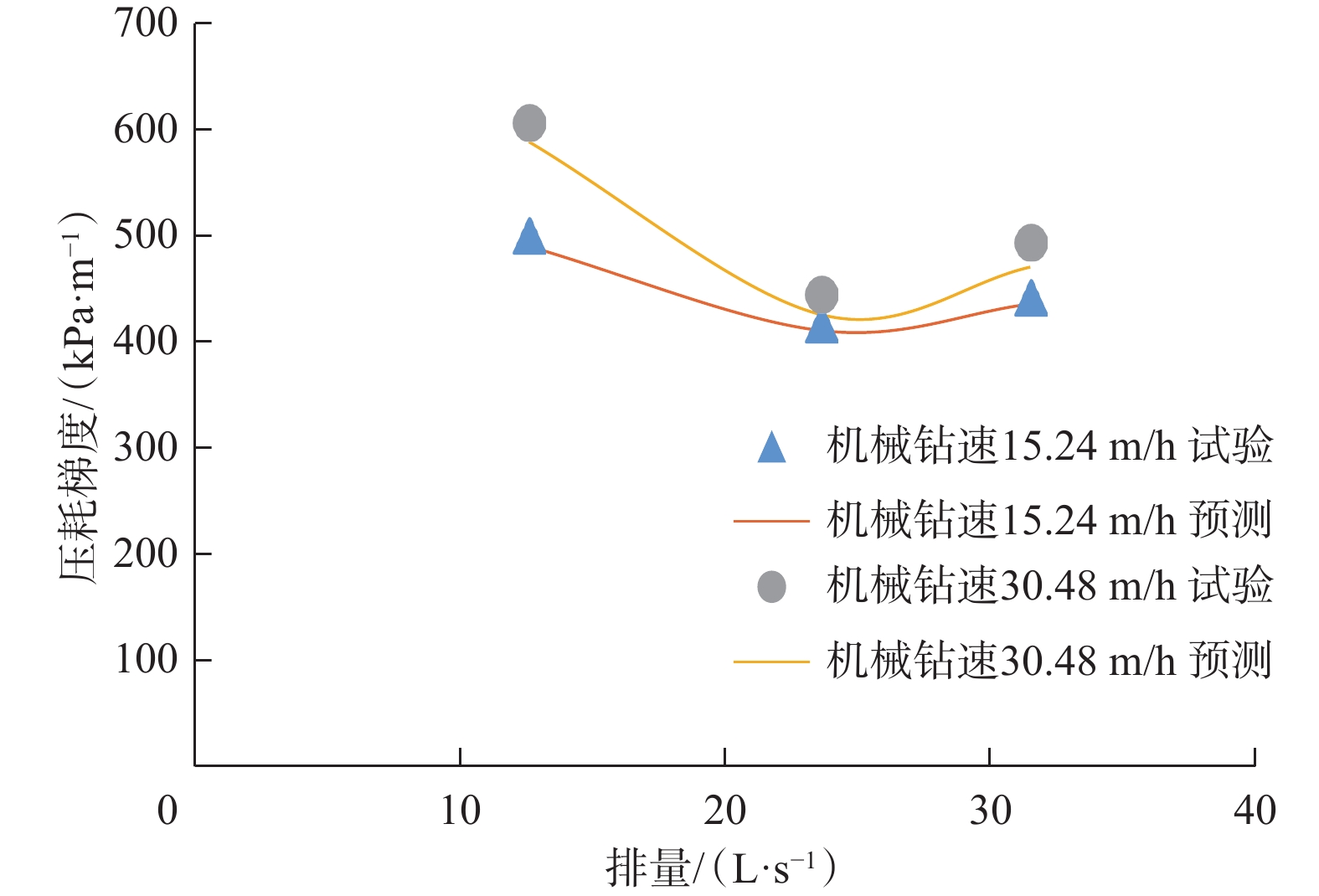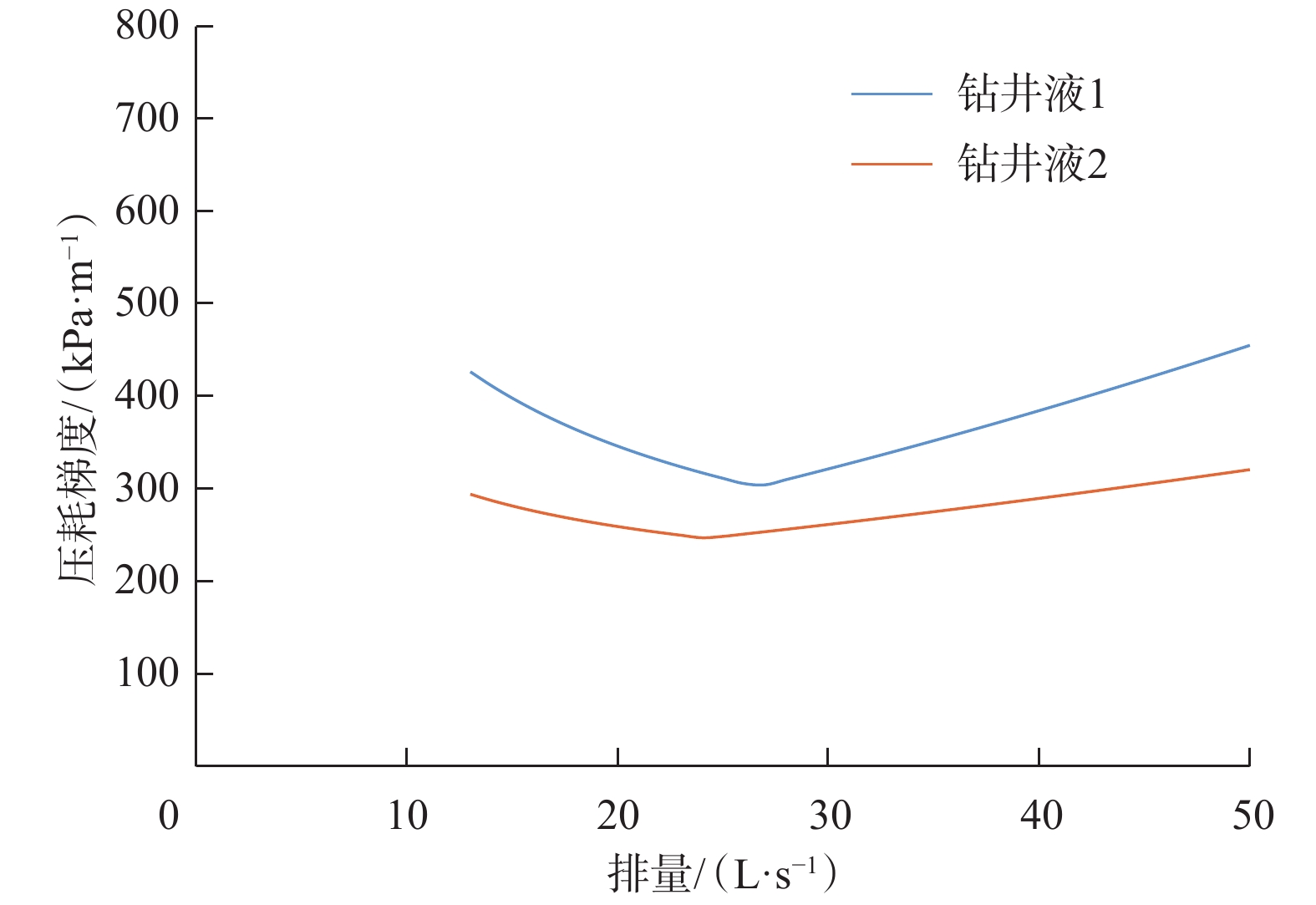A Method for Minimizing Annulus Pressure Loss by means of Hole Cleaning and Hydraulics Coupling
-
摘要:
在钻井过程中,岩屑在井眼中堆积形成岩屑床,会引起环空压耗增大。针对井眼清洁不充分造成的环空压耗大的问题,根据质量及动量守恒理论,将岩屑运移与钻井水力学计算相耦合,建立了井眼清洁程度与环空压耗相关的数学模型,并利用全尺寸岩屑运移试验数据进行了模型验证。利用所建模型,分析了排量、井斜角、环空尺寸、机械钻速和钻井液流变参数对环空压耗和井眼清洁程度的影响。结果表明:大位移井和水平井中由于存在岩屑,环空压耗并非随排量增大一直增大,而是存在一个临界值;排量小于临界值时,环空压耗随着排量增大而减小;排量大于临界值时,环空压耗随着排量增大而增大。根据分析结果,建立了基于井眼清洁与水力学耦合的环空压耗最小化计算方法,利用该方法可以优化钻井参数,控制环空压耗,指导钻井设计和钻井施工。
Abstract:Drill cuttings accumulate in the wellbore during drilling and form a cutting bed, which results in the increase of annulus pressure loss. To solve problem of large annular pressure loss from insufficient hole cleaning, a methodology in this study was developed to model the relationships between hole cleaning and annular pressure loss by coupling cuttings transport and annular pressure loss based on mass and momentum conservation. By using the developed model, the influence of parameters such as displacement, wellbore inclination, annulus size, rate of penetration (ROP) and rheological parameters of drilling fluid on annular pressure loss and degree of hole cleanliness were analyzed. The results show that annular pressure loss in extended-reach wells and horizontal wells does not increase with the increase of displacement due to cuttings in the well, but a critical value exists. When the displacement is below the critical value, the annular pressure loss decreases with the increase of displacement. However, pressure loss will increases with the increase of displacement when the displacement exceeds the critical value. Based on this result, a new calculation method is proposed to minimize annulus pressure loss by hole cleaning and annulus hydraulic coupling, which can be used in drilling parameters, control annulus pressure loss optimization and to guide drilling design and operation.
-
Keywords:
- hydraulics /
- hole cleaning /
- annulus pressure loss /
- cuttings transport /
- mathematical model
-
钻井过程中,由于井眼清洁不充分导致环空压耗过大是一个技术难点[1-2],尤其是大斜度井和大位移井中钻屑由于重力作用易沉降在下井壁,若清洁不及时,岩屑将会堆积形成岩屑床,使环空当量直径减小或沿程摩阻增大,造成环空压耗显著增大,导致钻井液漏失等一系列问题,在钻遇窄安全密度窗口地层时这一问题尤为突出。为了提高井眼清洁程度,需要降低由岩屑堆积引发的环空压耗。然而,如果为了降低岩屑体积分数或岩屑床高度而采用较大的排量,又会因为环空流速过高导致环空压耗增大。因此,为了降低环空压耗,必须将井眼清洁程度与环空压耗结合起来进行耦合研究。
国内外学者利用室内模拟试验和力学模型研究了井眼内岩屑运移规律。目前全世界大约有20套岩屑运移模拟试验装置[3],利用这些试验装置,国内外众多学者从多个角度进行了不同参数对岩屑运移影响的试验研究[4-9],先后提出了由试验得出的经验模型、两层水力模型、倾斜井中岩屑不沉积的最小环空流速模型和三层水力模型等不同模型,并不断进行修正或改进。经验模型受试验测试范围的限制,应用范围比较窄,在实际应用过程中局限性很大;而且经验模型只能用于井眼清洁计算,不能用于环空压耗计算。学者们对岩屑运移规律的研究较多,对岩屑运移机理认识得较清楚,但对井眼清洁程度和环空压耗相结合的研究比较少,基本没有进行考虑井眼清洁程度情况下的环空压耗最小化研究[3]。
笔者将井眼清洁程度与环空压耗计算耦合起来进行研究,首先通过分析试验数据证明环空压耗与井眼清洁程度有直接关系,然后建立岩屑运移和受岩屑影响的环空压耗计算模型,并利用该模型分析了排量、井斜角、环空尺寸、机械钻速和钻井液流变参数等因素对井眼清洁程度和环空压耗的影响,提出了基于井眼清洁程度与水力学耦合的环空压耗最小化计算方法。
1. 井眼清洁程度与环空压耗的关系
环空压耗与井眼清洁程度存在密切联系,试验研究表明[10],由于岩屑的存在,大位移井和水平井中的环空压耗并非随着流速增大而一直增大,不同井眼条件下环空压耗随流速的变化情况如图1所示(图1中:条件1为井斜角90°,滑动钻进,机械钻速15.24 m/h;条件2为井斜角90°,转速100 r/min,机械钻速15.24 m/h;条件3为井斜角90°,滑动钻进,机械钻速38.48 m/h;条件4为井斜角90°,转速100 r/min,机械钻速38.48 m/h)。
图1中的临界值(拐点)是岩屑与钻井液密度、环空有效面积和摩擦系数综合作用的结果。其作用原理是:1)岩屑与钻井液混合后,环空内流体的密度发生变化;2)倾斜井段或水平段的岩屑可能会沉降在环空下侧,使环空的有效流动面积减小,导致环空中流体流速增大,造成环空摩擦损失增加;3)岩屑床使环空表面粗糙度增大,导致压力损失增大。环空流速较低时,岩屑在重力作用会在环空下侧堆积形成岩屑床,使环空有效面积减小,并且使钻井液与环空表面的摩擦系数增大,而且钻井液中混入岩屑后的密度增大,这些因素使井眼摩擦阻力增大,从而导致环空压耗增大。随着流速增大,岩屑床高度降低,更多的岩屑会悬浮在钻井液中并被循环到井外,环空压耗随之减小。当流速超过一定值后,流速增大引起的摩擦损失明显增大,而岩屑体积分数和岩屑床高度对摩擦损失的影响相对较小,环空压耗开始增大。
2. 岩屑运移与环空压耗计算耦合模型
2.1 基本假设
笔者对三层水力学模型进行了改进,拓展了模型的适用性,并且简化了求解过程。基本假设如下:1)上液层没有岩屑(根据大量的试验结果得出的结论[11-13]);2)岩屑和流体在混合层中形成混合物,流体和颗粒之间不存在滑移;3)移动床层中的流体速度是恒定的;4)一个控制单元内岩屑床高度在井眼轴线方向不变,岩屑床孔隙度恒定;5)岩屑粒径均匀,所有岩屑均为球形。
2.2 基本方程
以斜井段为研究对象,运用质量及动量守恒理论,将岩屑运移与环空压耗计算相耦合,建立了井眼清洁程度与环空压耗之间的关系。
在给定机械钻速和流量的情况下,简化后的固相质量守恒公式为:
AsbCsbvsb+AmbCmbvmb=λAwvt (1) 液相质量守恒公式为:
Q=Asdvsd+Amb(1−Cmb)vmb+Asb(1−Csb)vsb (2) 式中:vsb为移动床层岩屑流速,m/s;vmb为混合层岩屑移动速度,m/s;vsd为上液层流体流动速度,m/s;Csb为岩屑床岩屑体积分数;Cmb为混合层岩屑体积分数;Asb为岩屑床层流动横截面积,m2;Amb为混合层流动横截面积,m2;Asd为悬浮层流动横截面积,m2;Aw为井眼流动横截面积,m2;Q为流量,m3/s;λ为生成岩屑体积分数修正系数;vt为机械钻速,m/s。
需要注意的是,vsb存在不为0的情况(详见后文),vsb的存在增大了模型的适用范围,提高了计算精度。另外,在钻进过程中,钻头钻进速度大于岩屑床移动速度,钻头或较大直径钻具与岩屑床之间会有空隙,并非所有岩屑都进入环空中,而是有一部分立刻沉降在钻头与原有岩屑床之间的空隙中,λ作为生成岩屑体积分数修正系数,有其存在的工程意义,经过严格推导,其计算公式为:
λ=Aw−A∗sb(1−ϕb)Aw (3) 式中:
A∗sb 为裸眼井段接近钻头处岩屑床截面积,m2;ϕb为岩屑床孔隙度。上液层的动量守恒方程为:
Asd(ΔpL)=−τsdSsd−τsmSsm−ρsdgAsdcosθ (4) 混合层的动量守恒方程为:
Amb(ΔpL)=−τmbSmb+τsmSsm−FmsL−FmbL−τmsSms−ρmbgAmbcosθ (5) 其中ρmb=ρL(1−Cmb)+ρsCmb (6) 当岩屑床静止时,该层动量方程可省略;当岩屑床流动时,岩屑床的动量守恒方程为:
Asb(ΔpL)=−FmsL−FsbL−τmsSms−ρmbgAmbcosθ (7) 式中:
ΔpL 为压力梯度,MPa/m;τmb为混合层与壁面(包括井眼和钻杆)之间的剪切应力,MPa;τsm为液层与混合层之间的剪切应力,MPa;τms为混合层与岩屑床层之间的剪切应力,MPa;τsd为壁面(包括井眼和钻杆)与上液层之间的剪切应力,MPa;ρsd为上液层密度,如果没有岩屑即为钻井液密度,kg/m3;ρmb为混合层密度,kg/m3;ρs为岩屑密度,kg/m3;ρL为钻井液密度,kg/m3;Ssd为井眼和钻杆与上液层之间的湿周,m;Smb为混合层与壁面(包括井眼和钻杆)之间的湿周,m;Ssm为上液层与混合层之间的湿周,m;Sms为混合层与岩屑床层之间的湿周,m;g 为重力加速度,m/s2;Fms为作用在岩屑床和混合层界面上的干摩擦力,N;Fmb为作用在混合层和壁面上的干摩擦力,N。根据岩屑床的受力分析(见图2),可以得到岩屑床静止与移动之间的转换条件。作用在岩屑床上的力包括重力、流动方向上的摩檫力、壁面的摩擦力和压力差。
岩屑床层顺环流流动方向运动的条件为:
(p1A1−p2A2)+τmbSmbL⩾ (8) 岩屑床静止的条件为:
\left( {{p_1}{A_1} - {p_2}{A_2}} \right) + {\tau _{{\rm{mb}}}}{S_{{\rm{mb}}}}L < \left( {{\tau _{\rm{b}}} + {\tau _{\rm{g}}}} \right){S_{\rm{b}}}L + G{\rm{cos}}\;\theta \!\! (9) \left( {{p_1}{A_1} \!-\! {p_2}{A_2}} \right) \!+\! {\tau _{{\rm{mb}}}}{S_{{\rm{mb}}}}L > \!-\! \left( {{\tau _{\rm{b}}} \!+\! {\tau _{\rm{g}}}} \right){S_{\rm{b}}}L \!+\! G{\rm{cos}}\;\theta \!\!\!\!\!\! (10) 岩屑床逆环流流动方向运动的条件为:
\left( {{p_1}{A_1} \!-\! {p_2}{A_2}} \right) \!+\! {\tau _{{\rm{mb}}}}{S_{{\rm{mb}}}}L \leqslant \!-\! \left( {{\tau _{\rm{b}}} \!+\! {\tau _{\rm{g}}}} \right){S_{\rm{b}}}L \!+\! G{\rm{cos}}\;\theta \!\!\! (11) 式中:A1和A2为岩屑床沿井筒方向上下两侧的面积,m2;p1和p2为岩屑床沿井筒方向上下两侧的压力,MPa;Sb为岩屑床的周长,m;L为单位岩屑床长度,m;τb为岩屑床的岩屑颗粒与外壁之间的剪切应力,Pa; τg为岩屑床内钻井液与外壁的剪切应力,Pa;G为重力,N;θ为井斜角,(°)。
2.3 闭合关系
试验时观察到岩屑床表面的岩屑是向前滚动而不是滑动。当岩屑开始在岩屑床表面滚动时,岩屑床高度开始下降。因此,岩屑滚动的临界速度可以认为是岩屑床层附近流体的速度。在力学模型中,岩屑床上方的平均流速可以认为是混合层的平均流速。利用岩屑滚动临界速度模型,可以计算出使岩屑颗粒滚动的临界流速,据此得到移动层的平均速度。岩屑床层与混合层之间存在岩屑交换:一方面,受重力影响,混合层的岩屑不断沉降到岩屑床层;另一方面,由于湍流悬浮和颗粒抬升的作用,沉降下来的岩屑被重新悬浮到混合层中。利用下文的悬浮岩屑分布方程,比较岩屑向上再悬浮和向下沉积的速度,得到混合层的岩屑体积分数分布。
2.3.1 岩屑滚动临界速度方程
在斜井段,位于岩屑床上的静止颗粒受到拖拽力(FD)、岩屑床支持力(FN)、举升力(FL)、压力(FP)和重力(G)作用,如图3所示(θpc为充填岩屑接触角,(°))。
当岩屑开始在岩屑床表面滚动时,岩屑所受力引起的力矩之和为:
T\! =\! \frac{{{d_{\rm{s}}}}}{2}\left[ {{F_{\rm{D}}}\sin {\theta _{{\rm{pc}}}} \!+\! {F_{\rm{L}}}\cos {\theta _{{\rm{pc}}}} \!- \!{F_{\rm{P}}}\cos {\theta _{{\rm{pc}}}} \!-\! G\left( {\theta \!+\! \sin {\theta _{{\rm{pc}}}}} \right)} \right] (12) 式中:T为岩屑所受力矩之和,N·m;FD为岩屑床上静止颗粒受到的拖拽力,N;FL为岩屑所受举升力,N;FP为岩屑所受压力,N;ds为岩屑的粒径,m。
经过一系列的推导[13],当力矩之和T等于0时,可以求得岩屑滚动临界速度,其表达式为:
{v_{\rm{c}}} = \sqrt {\frac{{6{\tau _y}\cos {\theta _{{\rm{pc}}}} + 4{d_{\rm{s}}}\left( {{\rho _{\rm{s}}} - {\rho _{\rm{L}}}} \right)g\sin (\theta + {\theta _{{\rm{pc}}}})}}{{3\left( {{C_{\rm{L}}}{\rho _{\rm{L}}}\cos {\theta _{{\rm{pc}}}} + {C_{\rm{D}}}{\rho _{\rm{L}}}\sin {\theta _{{\rm{pc}}}}} \right)}}} (13) 式中:vc为岩屑滚动临界速度,m/s;CD为拖拽系数;CL为举升力系数。
2.3.2 悬浮岩屑分布方程
求解上文模型需要了解悬浮岩屑在中间混合层的体积分数分布。在移动岩屑床中任取控制体积,则控制体积单位时间内岩屑量的变化如图4所示。
经过一系列的推导和整理后[13],得到悬浮岩屑扩散方程:
\frac{{\partial {C}}}{{\partial {t}}} = - {C}\frac{{\partial {{v}_{\rm{s}}}}}{{\partial {{y}}}} - {{v}_{\rm{s}}}\frac{{\partial {C}}}{{\partial {y}}} + \frac{{\partial \varGamma }}{{\partial {y}}}\frac{{\partial {C}}}{{\partial {y}}} + \varGamma \frac{{{\partial ^2}{C}}}{{\partial {{y}^2}}} (14) 式中:C为岩屑体积分数;vs为岩屑沉降速度,m/s;Γ为悬浮系数;y为计算点到环空低边井壁的距离,m。
岩屑沉降速度为:
{v_{\rm{s}}} = \sqrt {\frac{{4{{g}}{d_{\rm{s}}}\left( {{\rho _{\rm{s}}} - {\rho _{\rm{L}}}} \right)}}{{3{\rho _{\rm{L}}}{C_{\rm{D}}}}}} (15) 边界条件:移动层顶部的岩屑体积分数为0;移动层底部的岩屑体积分数与充填岩屑床体积分数相同。在钻柱到井壁的距离相同的情况下,假设岩屑体积分数是恒定的。利用有限差分法求解式(14),可求得移动床层中岩屑体积分数的分布。
2.4 模型的求解方法
在岩屑床静止的情况下,有Cmb,vmb,vsd,hsb,hmb和
\dfrac{{{\rm{\Delta }}p}}{L} 等6个未知量,可以联立式(1)、(2)、(4)、(5)、(13)和(14),求出这6个未知量。在岩屑床运动的情况下,有Cmb,vmb,vsd,vsb,hsb,hmb和
\dfrac{{{\rm{\Delta }}p}}{L} 等7个未知量,可以联立式(1)、(2)、(4)、(5)、(7)、(13)和(14),求解这7个未知量。模型求解之后,根据悬浮岩屑体积分数Cmb和岩屑床高度,即可自动求解出有效的岩屑体积分数,
\dfrac{{{\rm{\Delta }}p}}{L} 即为所求的环空压耗梯度。3. 模型验证
为了验证所建模型的可靠性,将模型计算结果与文献[9]中的试验数据进行了对比。试验用环空由ϕ200.0 mm井眼和ϕ127.0 mm钻柱组成,钻井液为幂律流体,密度为1 000 kg/m3,流性指数(n)为0.814,稠度系数为0.065 Pa·sn,试验参数见表1。
表 1 试验参数Table 1. Test parameters排量/(L·s–1) 转速/(r·min–1) 机械钻速/(m·h–1) 12.6 0,100 15.24,30.48 23.6 0,100 15.24,30.48 34.6 0,100 15.24,30.48 图5所示为井斜角60°、转速为100 r/min和机械钻速分别为15.24和30.48 m/h条件下,环空压耗梯度模型预测结果与试验结果的对比;图6所示为井斜角90°、机械钻速为30.48 m/h和转速分别为0和100 r/min条件下(转速为0是滑动钻进),环空压耗梯度模型预测结果与试验结果的对比。
由图5和图6可知,模型预测结果与试验结果基本吻合,证明模型预测结果较为准确,表明该模型可用于钻井过程中井眼清洁程度分析和环空压耗计算。
4. 影响环空压耗的因素
为了明确井斜角、泵排量、机械钻速和钻井液流变参数等对环空压耗的影响规律,利用上文模型计算了一口实钻井三开水平段钻进时的最小环空压耗。该井水平段裸眼直径为215.9 mm,钻柱外径为127.0 mm,钻井液性能与上文钻井液相同。该井的井身结构为:一开,ϕ444.5 mm钻头钻进,ϕ339.7 mm套管下至井深1 524.00 m;二开,ϕ311.1 mm钻头钻至井深2 440.00 m,ϕ244.5 mm套管下至井深2 438.00 m,水泥返至地面;三开,ϕ215.9 mm钻头钻至井深3 243.00 m,ϕ139.7 mm套管下至井深3 239.00 m,水泥返至井深1 478.00 m。
4.1 井斜角
假定滑动钻进,机械钻速保持15.24 m/h,利用上文所建模型计算不同井斜角下泵排量与岩屑体积分数以及环空压耗的关系,结果如图7和图8所示。
从图7可以看出:在相同井斜角下,随排量增大,岩屑体积分数减小;在大井斜角下,易形成稳定的岩屑床,且仅通过提高排量无法有效清除。
从图8可以看出,在相同井斜角下,随排量增大,环空压耗先降低后升高,存在在一个临界排量,井斜角增大临界排量也增大;在相同排量下,随井斜角增大环空压耗升高。
4.2 钻井液流变参数
选取密度均为1 000 kg/m3的2种钻井液,都属于幂律流体,钻井液1的的流性指数为0.814,稠度系数为0.065 Pa·sn;钻井液2的流性指数为0.720,稠度系数为0.025 4 Pa·sn。利用上文所建模型,计算使用这2种钻井液以转速100 r/min钻进水平段(井斜角90°,机械钻速30.48 m/h)时环空压耗与排量的关系,结果如图9所示。
从图9可以看出,使用钻井液1钻进时,环空压耗较大,临界排量也较大。2种钻井液的流性指数相差不大,而钻井液1的稠度系数大,说明稠度系数大,黏度高,环空压耗就大。
4.3 环空尺寸
利用上文所建模型,计算2种环空条件下环空压耗与排量的关系,结果如图10所示。环空1的尺寸为ϕ230.0 mm×ϕ114.0 mm,环空2的尺寸为ϕ244.0 mm×ϕ114.0 mm。从图10可以看出,随着环空尺寸增加,环空压耗降低,但是临界排量反而增大。这是因为环空尺寸增大使环空流速降低,减小了钻井液摩擦阻力消耗,但是流速降低使钻井液的携岩能力下降,从而使与井眼清洁相关的临界排量增大。
4.4 机械钻速
使用稠度系数为0.065 Pa·sn、流性指数为0.720的钻井液,以转速100 r/min钻进水平段(井斜角为90°),利用上文所建模型计算不同机械钻速下环空压耗与排量的关系,结果如图11所示。
从图11可以看出,随着机械钻速增大,环空压耗增大,临界排量也相应增大。这是因为随着机械钻速升高,环空中悬浮岩屑的量和岩屑床高度都会增加,导致环空流速和流体平均密度增大,从而使环空压耗增大。
5. 环空压耗最小化方法
如上所述,钻井过程中钻井液排量与环空压耗之间并非简单的线性关系,而是存在一个临界值。排量低于临界值时,环空压耗随着排量增大而减小;排量大于临界值时,环空压耗开始随着排量增大而增大。临界排量会随着钻井液流变参数、机械钻速和井斜角等参数变化而发生变化。钻井过程中降低钻井液流动导致的环空压耗(即ECD与静态钻井液密度之差),对避免漏失、井控和保护储层等都具有重要作用;尤其是在安全密度窗口比较窄的情况下,降低环空压耗对保证钻井安全顺利进行至关重要。因此,将井眼清洁程度与环空压耗进行耦合来优化钻井参数具有现实意义。
为了提高大位移井井眼清洁程度,除了降低环空压耗,还要考虑钻柱摩阻的影响。岩屑床会增大钻柱的摩阻,造成钻头加压困难、钻速低,甚至导致托压、卡钻等一系列问题。为避免出现这些问题,要将岩屑床控制在一定范围内。实际钻井设计和施工过程中,可以先满足摩阻损失方面的要求,然后根据排量与环空压耗之间的关系,确保环空压耗最小,实现井眼清洁和钻井参数优化,达到快速高效钻进的目的。在地质条件复杂、钻井液安全密度窗口窄的情况下,可以通过降低钻速来降低环空压耗,同时满足摩阻损失的要求,实现安全顺利钻穿复杂地层,具体计算流程如图12所示。
6. 结 论
1)将井眼清洁程度与环空压耗进行耦合来优化钻井泵排量,可获得满足井眼清洁条件的最小环空压耗,这对钻遇窄安全密度窗口地层具有重要作用。
2)最小环空压耗所对应的临界排量会随着钻井液流变参数、机械钻速和井斜角等参数变化而变化。
3)根据钻井工艺要求,提出了钻井设计过程中以环空压耗最小来优化钻井参数的方法和设计流程。
-
表 1 试验参数
Table 1 Test parameters
排量/(L·s–1) 转速/(r·min–1) 机械钻速/(m·h–1) 12.6 0,100 15.24,30.48 23.6 0,100 15.24,30.48 34.6 0,100 15.24,30.48 -
[1] 苏义脑,窦修荣. 大位移井钻井概况、工艺难点和对工具仪器的要求[J]. 石油钻采工艺, 2003, 25(1): 6–10. doi: 10.3969/j.issn.1000-7393.2003.01.022 SU Yinao, DOU Xiurong. General conndition and technical difficulties of extended reach well drilling and its requirements on tools and instruments[J]. Oil Drilling & Production Technology, 2003, 25(1): 6–10. doi: 10.3969/j.issn.1000-7393.2003.01.022
[2] MSSIE G W, SMITH J, LEE J W, et al. Amoco’s training initiative reduces wellsite drilling problems[J]. Petroleum Engineer International, 1995, 67(3): 30–45.
[3] LI J, LUFT B. Overview of solids transport studies and applications in oil and gas industry: experimental work[R]. SPE 171285, 2014.
[4] BUSCH A, ISLAM A, MARTINS, D W, et al. Cuttings-transport modeling: part 1: specification of benchmark parameters with a norwegian-continental-shelf perspective[J]. SPE Drilling & Completion, 2018, 33(2): 57–67.
[5] BIZHANI M, KURU E. Particle removal from sandbed deposits in horizontal annuli using viscoelastic fluids[J]. SPE Journal, 2018, 23(2): 256–273. doi: 10.2118/189443-PA
[6] ARNIPALLY S K, KURU E. Settling velocity of particles in viscoelastic fluids: a comparison of the shear-viscosity and elasticity effects[J]. SPE Journal, 2018, 23(5): 1689–1705. doi: 10.2118/187255-PA
[7] NAGANAWA S, SATO R, ISHIKAWA M. Cuttings-transport simulation combined with large-scale-flow-loop experimental results and logging-while-drilling data for hole-cleaning evaluation in directional drilling[J]. SPE Drilling & Completion, 2017, 32(3): 194–207.
[8] 孙晓峰,纪国栋,冯松林,等. 幂律流体中岩屑颗粒沉降速度实验[J]. 断块油气田, 2016, 23(1): 120–124. SUN Xiaofeng, JI Guodong, FENG Songlin, et al. Cuttings particle settling velocity within power law fluid[J]. Fault-Block Oil & Gas Field, 2016, 23(1): 120–124.
[9] ZHANG Feifei. Numerical simulation and experimental study of cuttings transport in intermediate inclined wells[D]. Tulsa: The University of Tulsa, 2015.
[10] MATOUSEK V. Pressure drops and flow patterns in sand-mixture pipes[J]. Experimental Thermal and Fluid Science, 2002, 26(6/7): 693–702.
[11] HYUN C, SUBHASH N S, OSISANYA, S O. A three-segment hydraulic model for cuttings transport in horizontal and deviated wells[R]. SPE 65488, 2000.
[12] NGUYEN D, RAHMAN S S. A three-layer hydraulic program for effective cuttings transport and hole cleaning in highly deviated and horizontal wells[R]. SPE 51186, 1998.
[13] OZBAYOGLU M E, MISKA S Z, REED T, et al. Cuttings transport with foam in horizontal and highly-inclined wellbores[R]. SPE 79856, 2003.
-
期刊类型引用(12)
1. 荆思霖,宋先知,孙一,许争鸣,周蒙蒙. 基于压差法的水平井岩屑床轴向运移规律研究. 石油钻探技术. 2024(01): 54-61 .  本站查看
本站查看
2. 侯晓东,卢华涛,张爽,席志旭. 考虑参数不确定性的井筒压力实时校正方法研究. 自动化应用. 2024(08): 19-21 .  百度学术
百度学术
3. 臧传贞,荆思霖,路宗羽,宋先知,武兴勇. 小井眼水平井洗井岩屑清除效率研究. 石油钻探技术. 2024(03): 75-83 .  本站查看
本站查看
4. 舒惠龙,田中兰,付利,杨恒林,杨磊,范玉光. 水平井井眼清洁定量化监测评价技术. 石油钻探技术. 2023(02): 68-73 .  本站查看
本站查看
5. 李果,陈建华,莫海涛,刘修刚. 煤矿区长水平定向钻进环空泥浆冲洗液最小排量计算方法研究. 煤炭技术. 2023(12): 196-199 .  百度学术
百度学术
6. 胡金帅,张光伟,李峻岭,陈雨,闫丰平. 基于CFD-DEM耦合模型的岩屑运移数值模拟分析. 断块油气田. 2022(04): 561-566 .  百度学术
百度学术
7. 韩雪莹,李衡,王汉卿,刘丹婷,张海超,夏成宇. 脉冲射流式岩屑床清理工具的研究. 机床与液压. 2022(18): 26-30 .  百度学术
百度学术
8. 叶佳杰,孔祥伟,张雷,陈青,甘洲. 大肚子水平井钻井液性能对岩屑运移规律模拟分析. 当代化工. 2022(09): 2199-2202+2219 .  百度学术
百度学术
9. 刘俊彦,林家昱,刘海龙,窦蓬. 渤海油田大位移定向钻井关键技术. 天津科技. 2021(04): 39-42 .  百度学术
百度学术
10. 张洁,汤明,蒋振新,甘一风,曾德智. 椭圆井眼同心环空赫巴流体流动规律研究及压降计算简化模型. 特种油气藏. 2021(02): 156-162 .  百度学术
百度学术
11. 宋昱播,刘修刚. 煤层底板灰岩多分支水平注浆井钻进摩扭分析及控制措施研究. 煤炭技术. 2021(08): 127-129 .  百度学术
百度学术
12. 陈雨微,张菲菲,吴涛,王越之,王茜. 大位移井井眼清洁与ECD控制. 中国科技论文. 2021(09): 1017-1022 .  百度学术
百度学术
其他类型引用(7)




 下载:
下载:





































